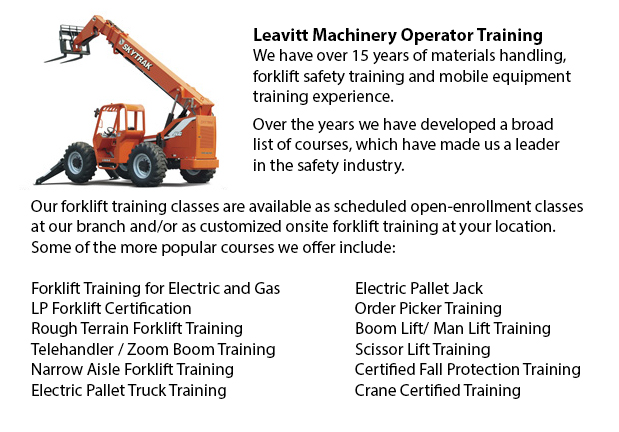
Kitchener Telehandler License - The telescopic handler or telehandler is a frequently utilized machine in agricultural and industrial applications. This equipment is the same in look to a forklift and likewise works in a similar manner, even if telehandlers are much more like a crane than lift truck. It has a telescopic boom that can lengthen upward and forwards from the vehicle. The boom has the capability to fit one of various accessories like muck grab, pallet forks, a bucket or a lift table.
Pallet blades are the most popular attachment meant for the telehandler. This particular equipment is normally used for transporting loads to and from places which a conventional forklift will find unreachable. Telehandlers are specially helpful for placing loads on rooftops for example, or for removing palletized cargo from with a trailer. A lot of the jobs that a telehandler can carry out will otherwise need a crane and this piece of equipment could be pricey, not practical and not always time efficient.
The boom acts as a lever, raising and extending while bearing a load. Even if there are back counterweights, this can cause the telehandler to become more unbalanced. Thus, the greatest advantage of the telehandler is likewise its greatest limitation. As the working radius increases, the lifting capacity decreases. The working radius is defined as the distance between the front of the wheels and the center of the load.
For example, a telehandler with a 5000 lb capability with the boom retracted can safely lift as little as 400 lb when it is fully extended at a low boom angle. The equivalent machine that has a 5000 lb lift capacity and the boom retracted could support as much as 10,000 lb with the boom raised to 70 degrees. The operator has a load chart to be able to help determine whether a certain lifting job could be accomplished in an efficient and safe manner. This particular chart takes into account the weight, height and the boom angle.
Several telehandlers come equipped together with a computer that makes use of sensors to be able to monitor the motor vehicle. These sensors will alert the operator and some are capable of cutting off further control input if the limits of the vehicle are exceeded. Some telehandler models are likewise equipped together with front outriggers which are known as mobile cranes. These significantly extend the lifting capability of the equipment while it is stationary.
-
Kitchener Forklift Training Schools
Kitchener Forklift Training Schools - The Advantages Of Taking One Of Our Forklift Training Schools Are you searching for work as a driver of a forklift? Our regulatory-compliant mobile equipment operator training offers instruction in types of fo... More -
Kitchener Overhead Crane Operator Training
Kitchener Overhead Crane Operator Training - Our overhead crane operator training course is designed to teach employees the basics of overhead crane/sling operation and pre-shift checks. Courses are taught by our expert trainers and consultants. Well... More -
Kitchener Crane Training School
Kitchener Crane Training School - The crane training school offers industry-relevant programs. Courses provide trainees with learning outcomes which match present industry demands. Our small class sizes combine hands-on experience and theory. Our qua... More -
Kitchener Skid Steer Ticket
Kitchener Skid Steer Ticket - The lift arms on the skid-steer loader are located at the side of the driver along with pivots behind the driver's shoulders. These features makes the skid-steer loader different as opposed to the conventional front load... More -
Kitchener Manlift Operator Certification
Kitchener Manlift Operator Certification - Our scissor platform and aerial lift training and certification empowers participants with a knowledge and general understanding of the efficient and safe use of "Power Operated Mobile Work Platforms," under... More -
Kitchener Crane Safety Training
Kitchener Crane Safety Training - Companies and crane operators have to be aware of the problems related to crane safety. Legislation provides rules for the safe operation, inspection and maintenance of lifting machines all around North America. Cran... More -
Kitchener Forklift Training Programs
Kitchener Forklift Training Programs - Are you searching for work as a forklift driver? Our regulatory-compliant mobile equipment operator training offers instruction in kinds of forklifts, pre-shift check, fuel kinds and dealing with fuels, and safe... More -
Telehandler Training in Kitchener
Telescopic handlers often known as telehandlers for short, are an extremely popular piece of heavy construction machinery. They are commonly used in the construction and agricultural industries. These equipments have extreme reaching ability and can... More

Forklift Certification Kitchener
TOLL FREE: 1-888-254-6157
Kitchener, Ontario
forkliftcertificationkitchener.com
Email Us
About Us


